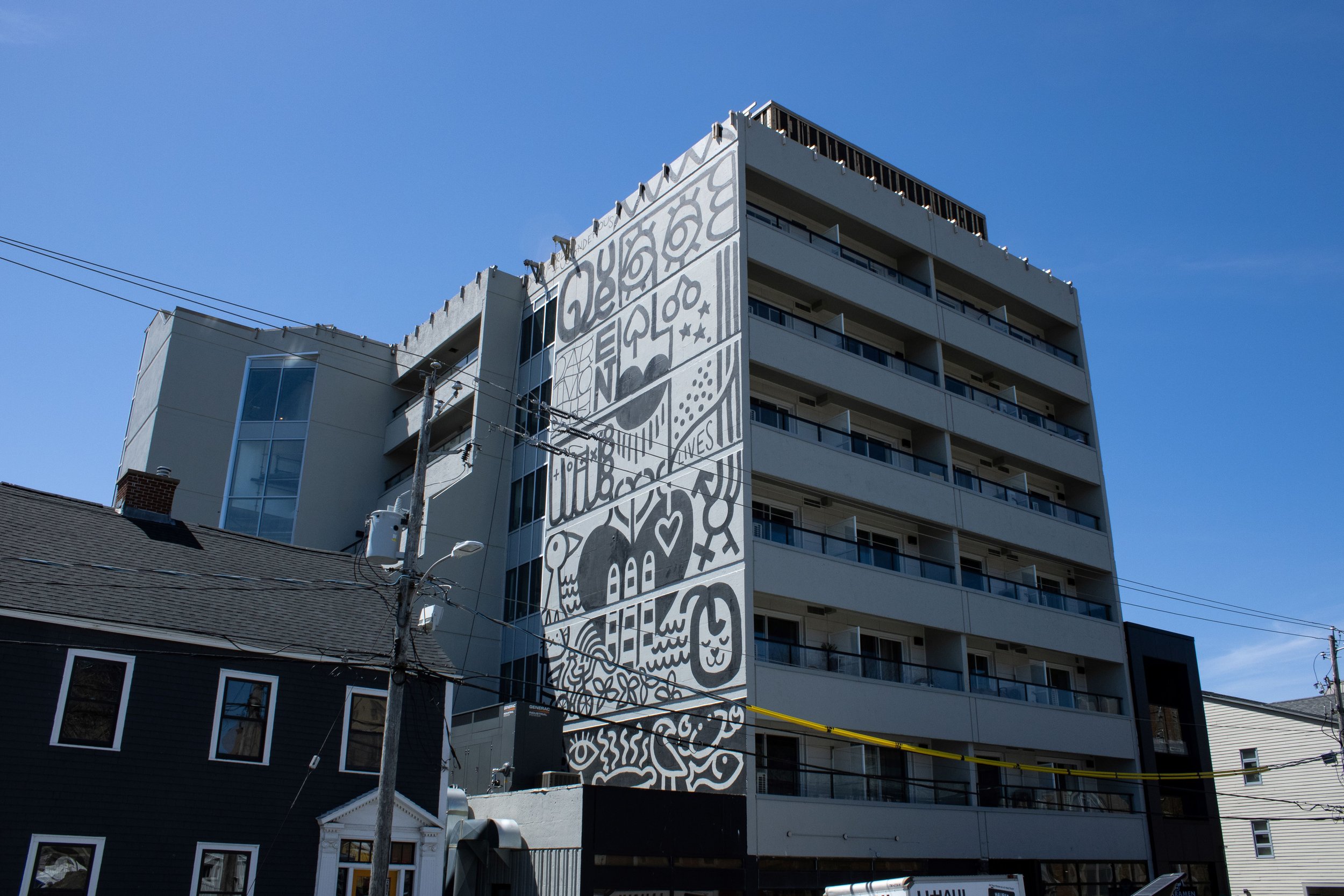Concrete reasons to support building repurposing
Repurposing a late 60s concrete hotel provides climate-friendly housing in downtown Dartmouth.
By Zack Metcalfe, Climate Story Network
The Shuffle today. It’s final floor is being completed in 2024, but the rest of the building welcomed tenants in 2023. Photo courtesy of Sidewalk.
Maranova was built in the late 1960s or shortly thereafter; a 71-unit Dartmouth hotel considered big for its time, and relatively high-end. Later it became a Super 8, then the Dartmouth Ocean View Hotel, then nothing, just another derelict building in extreme disrepair — the sore thumb of downtown Dartmouth.
This didn’t sit well with Sidewalk, a real estate developer which had, by this time, invested considerably in the surrounding neighbourhood. To let the old Maranova sit there and decay was more than they could stomach, so, in 2019, they bought it, and in an unlikely move, didn’t tear it down.
“The hotel was in very bad condition,” said Joe Nickerson, Sidewalk’s vice-president. “It was probably in one of the worst capital improvement conditions we’d ever consider taking on for a renovation.”
In its 50 years of operation, Maranova saw little in the way of improvement or retrofit; everything leaked, and nothing worked. But the building had one lingering asset on which Sidewalk hung its hat – concrete.
“A properly built concrete building should last several hundred years,” said Anne Lombardi, an energy consultant and vice president of Integral Energy Performance, a building energy modelling and analysis firm based in Halifax, currently acting as Sidewalk’s energy consultant on the project.
Concrete is also one of the most carbon intensive building materials on the planet, accounting for about 9 per cent of global emissions. Reusing concrete from the 1960s, said Lombardi, means not pouring more in the 2020s. This is the concept of “embodied carbon,” the greenhouse gases emitted to construct a building in the first place, and avoided when its materials are reused. In some cases, said Lombardi, concrete can represent 60 per cent of a building’s embodied carbon.
Concrete matters for more than its longevity, said Nickerson. By reusing the Maranova’s concrete, Sidewalk is easing the burden on an overloaded trades market. Canada needs housing, he said, and there aren’t enough people pouring concrete to meet demand.
“If we go and do a new development,” said Nickerson, “I need to stand in the back of the cue like everyone else, to get a formworker, someone to dig the hole, someone to tear down the old building, and someone to pour new concrete; those early stage processes that every other multi-family project in the downtown are using. We’d be tying up a pretty tapped trades market by tearing down the building.”
“I think they very much did the right thing with Maranova,” said Lombardi. “I think it sets a really nice precedent for doing this in more buildings.”
By December of 2023, Sidewalk had stripped the Maranova Hotel down to its concrete skeleton, then built an 81-unit apartment building within the building shell. They now call it “The Shuffle,” a subtle play on its location at the intersection of King and Queen streets. Modelling suggests its energy use was reduced by 42 per cent in the course of the renovation, achieved with upgraded insulation, windows, ducted heat pumps, and energy recovery ventilators. These savings earned grants through Efficiency Nova Scotia and preferred financing through the Canadian Mortgage and Housing Corporation (CMHC), but neither program rewarded their reuse of old concrete.
“None of the programs they applied for gave them any kind of value for that embodied carbon,” said Lombardi. “Efficiency Nova Scotia and the CMHC don’t recognize avoided emissions from embodied carbon. These programs just aren’t built for it.”
This, she said, is a problem. Reusing old concrete can be inconvenient, restricting developers to the rough size and shape of the original building. It’s one reason the market is focused so heavily on new construction, tearing down old concrete, and pouring more. But embodied carbon must be taken seriously in provincial and federal climate planning, said Lombardi, because there’s so much of it. Part of those plans should be to incentivize projects like Maranova, rewarding reused concrete in the same way they reward energy efficiency.
Sidewalk didn’t calculate the amount of embodied carbon spared when they built The Shuffle, but when it came time to convert a 200,000 square foot office tower in downtown Halifax (The Centennial Building) into a mixed residential and commercial complex of 173 loft units, they decided to do the math. By reusing this building’s concrete skeleton, they’re bringing homes to Halifax for 500 fewer tonnes of carbon than would a new building of the same size. These avoided tonnes won’t be incentivized, even though the 67 per cent drop they estimate in the Centennial’s operational energy use certainly will be. Sidewalk hopes to finish the Centennial’s renovation by May of 2025, at which point it’ll be called Agency Art Lofts.
“We were able to see massive energy savings,” said Nickerson, “but there was no carrot, no funding, nothing attached to the avoided embodied carbon. If there was a way of incentivizing that, it could make the difference. It could make a project worth renovating, whereas the lack of an incentive makes it more efficient to tear down and build new.”

